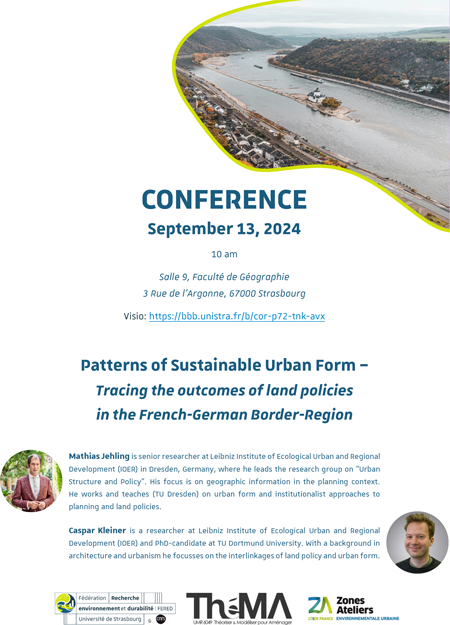 Dans le cadre de la visite de Mathias Jehling et de Casper Kleiner (Leibniz Institute of Ecological Urban and Regional Development à Dresde, Allemagne), Manon Kohler organise un séminaire conjoint Zone Atelier Environnementale et Urbaine (ZAEU)/Fédération de Recherche en Environnement et Durabilité (FERED)/ThéMA, intitulé « Patterns of Sustainable Urban Form – Tracing the outcomes of land policies in the French-German Border-Region ».
Dans le cadre de la visite de Mathias Jehling et de Casper Kleiner (Leibniz Institute of Ecological Urban and Regional Development à Dresde, Allemagne), Manon Kohler organise un séminaire conjoint Zone Atelier Environnementale et Urbaine (ZAEU)/Fédération de Recherche en Environnement et Durabilité (FERED)/ThéMA, intitulé « Patterns of Sustainable Urban Form – Tracing the outcomes of land policies in the French-German Border-Region ».
Le séminaire aura lieu le 13 septembre de 10h à 11h à la faculté de Géographie de Strasbourg mais il sera retransmis en visioconférence, en grande salle de réunion à ThéMA (3e étage). Vous aurez également la possibilité de le suivre directement depuis ce lien : https://bbb.unistra.fr/b/cor-p72-tnk-avx
Mathias Jehling is senior researcher at Leibniz Institute of Ecological Urban and Regional Development (IOER) in Dresden, Germany, where he leads the research group on “Urban Structure and Policy”. His focus is on geographic information in the planning context. He works and teaches (TU Dresden) on urban form and institutionalist approaches to planning and land policies.
Caspar Kleiner is a researcher at Leibniz Institute of Ecological Urban and Regional Development (IOER) and PhD-candidate at TU Dortmund University. With a background in architecture and urbanism he focusses on the interlinkages of land policy and urban form.
Abstract : Urban form is a key element for the objective of sustainable development of cities and regions. Especially in Europe, policy makers have started implementing land policies aiming for characteristics of urban form like density, accessibility, lower land-take rates or more diverse building types than single family houses to achieve this goal. While general trends towards lower rates of land-take are measurable, general urbanisation trends are still defined by patterns of new land-take, predominance of single-family houses and urban sprawl. The question arises, whether land policies actually have an impact on urban form and whether different land policy settings lead to different patterns in urban form. Therefore, this contribution explores the research question “What patterns of urban from emerge in different land policy systems?”. The broad availability of geo-data analysis approaches and data from harmonised national data sources allow for large scale analysis of urban form patterns. To compare these patterns of urban form in different land policy systems, a setting is required that limits other factors on urban form like demographic, economic or cultural development from land polices. Here, the French-German border-region serves as a suitable study area. A geospatial model is set up containing building footprint, parcel and street network information from national data-sources. We derive urban development projects of different periods which are then assessed for their characteristics of urban form, i.e. compactness, density, building types, and accessibilities. The concept sustainability is used as a lens through which these characteristics are assessed. The analysis allows a closer look into the patterns of urban form emerging in the two land policy settings and lays the basis for further assessing land policy impacts in the two different policy systems.
Keywords : comparative analysis, urban form, morphometrics, land policy, sustainability
